You're using an outdated browser. Please upgrade to a modern browser for the best experience.
Please note this is a comparison between Version 1 by Wei Zhang and Version 2 by Catherine Yang.
MXene, 2D transition metal carbides, nitrides, and carbonitrides with a unique 2D structure, inspired a series of function applications related to energy storage and conversion, biometrics and sensing, lighting, purification, and separation. Its surface terminations are confined by the adjacent MXene layers, and form the 2D planar space with symmetrical surfaces, which is similar to a 2D nanoreactor that can be utilized and determined MXene’s function. Accurate characterization of MXene surface terminations is the prerequisite for studying the regulatory methods and the influence of properties and performance. Because the surface termination of MXene presents two-dimensional plane distribution and the collision probability of atoms, molecules, electrons, and optical signals is low. MXene prepared by chemical methods has certain impurity content. In addition, most surface terminations do not exist in a stable state, which leads to the difficulty of the accurate characterization of MXene surface terminations. At present, XPS, EDX, XAS and EELS are often used for qualitative and quantitative analysis of MXene surface terminations.
- MXene
- surface terminations
- modification
- characterization
1. XRD
Although X-ray diffraction (XRD) cannot directly capture the differences of elements in the surface terminations of MXene, the evolution of MXene interlayer space induced by the dissimilar surface terminations can be deduced via the calculated MXene lattice parameters. As a basic crystal structure characterization technology, the statistical analysis of MXene crystal structure by XRD can indirectly reflect the modulating action of MXene surface termination on MXene crystal structure and the interlayer environment. Based on the information of new peak appearance, peak position shift, and half-peak width change, the surface termination atom arrangement and its induced structural evolution can be analyzed indirectly.
Figure 13 a shows the XRD patterns of the initial phase Ti 3 AlC 2 and intermediate product Ti 3 ZnC 2 . The XRD peaks of Ti 3 ZnC 2 , such as (103) and (104), shift to a lower angle than those of Ti 3 AlC 2 , indicating that the substitution of Al atoms by Zn atoms results in a larger lattice constant. The relative intensities of peaks (004) and (006) increase, while the relative intensities of peaks (002) decrease, resulting from structural factor changes caused by the substitution of A atoms [1][ 27 ]. Figure 13 b shows the XRD patterns of the reaction products Ti 3 C 2 Cl 2 and HCl rinsed products. Except for the diffraction peak characteristics of zinc, the XRD patterns of the reaction products are similar to those of Ti 3 C 2 MXene prepared by the HF etching method. The (104) peak of Ti 3 AlC 2 is significantly weakened or disappeared, in addition to the downward shift of the (002) peak to a lower Angle, attributed to the increased C lattice parameters. The C lattice parameter is consistent with the theoretical value calculated by DFT and larger than Ti 3 C 2 T x generated by HF etching [ [2]2 ]. Note that unlike the typical wide (00L) peak of Ti 3 C 2 T x produced by HF etching, the (00L) peak of Ti 3 C 2 Cl 2 is sharp and intense, indicating an ordered crystal structure. Therefore, MXene prepared by this method with -Cl as the surface termination has a stronger XRD peak and a more orderly crystal structure. Other MXene with different functional groups also have different manifestations in the XRD. As shown in Figure 13 c, the (002) characteristic peaks of Ti 3 C 2 -O and Ti 3 C 2 -S obtained by treating molten salt-assisted electrochemical (MS-E) etched Ti 3 C 2 Cl 2 with Li 2 O and Li 2 S were further shifted from 8.18° to lower angles of 7.48° and 6.88°. This is attributed to the C lattice parameters ranging from 21.9 Å to 23.6 Å and 25.9 Å [ [3]44 ].
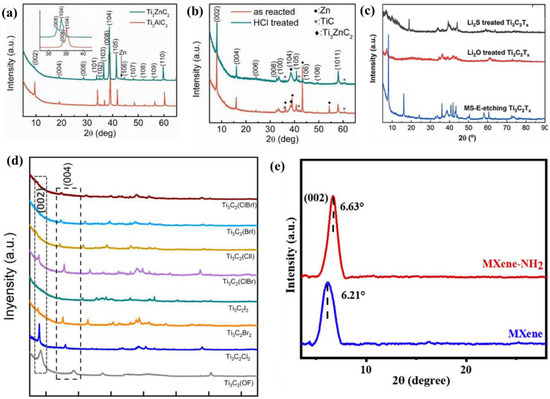
Figure 13. ( a ) Comparison of XRD patterns between Ti 3 AlC 2 and intermediate Ti 3 ZnC 2 [1] [ 27 ]. ( b ) XRD patterns of reaction products and HCl rinsed products [2][ 2 ]. ( c ) XRD patterns of Ti 3 C 2 -O and Ti 3 C 2 -S [3][ 44 ]. ( d ) The XRD patterns of halogen termination MXene were compared [4][ 28 ]. ( e ) XRD patterns of MXene-NH 2 [5] [ 55 ].
Figure 13 d shows the XRD patterns of MXene and Ti 3 C 2 (OF) at halogen terminations. It is found that Ti 3 C 2 Cl 2 and Ti 3 C 2 (OF) have strong (002) peaks, corresponding to the C values of 20.90 and 22.22 Å, respectively. The (002) peaks of Ti 3 C 2 Br 2 and Ti 3 C 2 I 2 are not very clear, but the (004) peaks are strong enough. Sufficient to determine their respective C values of 23.33 and 25.00 Å, which are slightly larger than the theoretical values calculated by density functional theory (DFT) (23.02 and 24.24 Å). This indicates that the layer spacing of MXene connecting halogen groups increases successively with the radius of halogen groups. The increased layer spacing in Ti 3 C 2 Br 2 and Ti 3 C 2 I 2 can be interpreted as an increase in the atomic radius of the halogen group from fluorine to iodine. Different termination atoms will lead to different structure factors of MXene, resulting in different relative intensities of the (00L) peak. The c-value of binary and ternary halogen-terminated MXene is between that of monoid halogen-terminated MXene. For example, the C value of Ti 3 C 2 (BrI) (24.06 Å) is larger than that of Ti 3 C 2 Br 2 , but smaller than that of Ti 3 C 2 I 2 [4] [ 28 ].
Figure 13 e shows the XRD patterns of conventional MXene and MXene with amino surface functionalization. Compared with the peak (002) of MXene at 6.21°, the peak (002) shifted to a large angle of 6.63° after -NH 2 functionalization. It shows that their D-spacing decreases from 1.42 nm to 1.33 nm. The decrease in D-spacing is due to the introduction of positively charged amino groups on the surface of MXene-NH 2 , which reduces the repulsive force of the original negative charge on the MXene nanosheet. Therefore, the small D-spacing in MXene-NH 2 can be judged by XRD [ [5]55 ].
2. SEM and EDS
Figure 14 2a,b show SEM images of Ti 3 AlC 2 and Ti 3 ZnC 2 powders. The Ti 3 AlC 2 precursor exhibits a typical MAX phase layered structure. In contrast, the layered structure of Ti 3 ZnC 2 becomes less pronounced, probably due to the dissolution of the powder edges in the molten salt. Ti 3 C 2 Cl 2 was obtained by adding excessive zinc chloride. Figure 214 c,d shows the semi-quantitative analysis of SEM of Ti 3 C 2 Cl 2 and the corresponding EDS (energy dispersive spectroscopy). Typical accordion-like morphology was found, and the main elements were Ti (43.2 at.%), C (21.5 at.%), and Cl (25.3 at.%). As well, small amounts of Zn (0.7 at.%), Al (2.9 at.%), and O (6.3 at.%). The presence of Zn, Al, and O is plausible because ubiquitous O-containing compounds, such as Al(OH) 3 , are hydrolysates of AlCl 3 .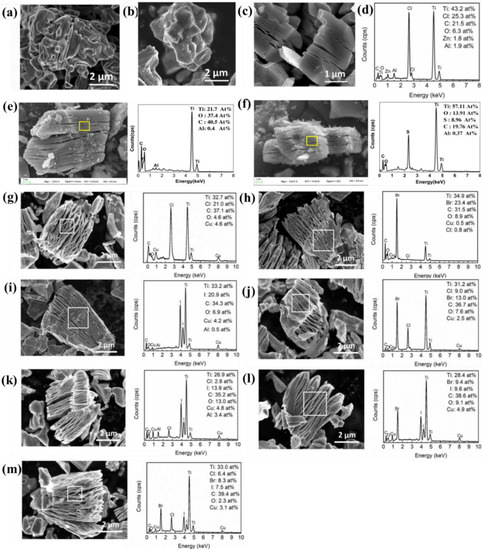
Figure 214. ( a ) SEM image of Ti 3 AlC 2 powder [1][ 27 ]. ( b ) Ti 3 ZnC 2 powder [1][ 27 ]. ( c ) Ti 3 C 2 Cl 2 . ( d ) The corresponding EDS [1][ 27 ]. ( e ) SEM image of -O termination MXene. ( f ) -S termination MXene [3][ 44 ]. ( g – m ) SEM and EDS analysis of halogen termination MXene [ [4]28 ].
3. XPS
XPS can accurately measure the inner electron binding energy and chemical shift of atoms, provide information on molecular structure and valence state, and provide information on element composition and content, chemical state, and molecular structure. In addition, because the X-ray beam incident on the sample surface is a photon beam, the damage to the sample is very small. XPS is used as the most conventional means to analyze the surface terminations of MXene. With the accurate representation of XPS elements, the valence states, chemical bonds, and chemical shifts of surface termination elements are collected. Meanwhile, the mechanism of the surface termination formation process can be obtained by comparing the XPS high-resolution spectrogram. Providing support for the development of differentiated surface terminations is one of the most powerful characterization techniques in MXene surface termination research. XPS spectra of Ti 2p and Cl 2p of Ti 3 C 2 Cl 2 are shown in Figure 315 a. The peaks at 454.4 eV and 455.7 eV are assigned to the Ti-C(I) (2p 3/2 ) and Ti-C (II) (2p 3/2 ) bonds [ [6]56 , [7]57 ]. The peak at 458.1 eV belongs to the high-valence Ti compound, which is assigned to the Ti-Cl (2p 3/2 ) bond [ [8]58 , [9]59 ]. In addition, the peaks at 460.3 eV, 461.8 eV and 464.1 eV are attributed to Ti-C (I) (2p 1/2 ), Ti-C (II) (2p 1/2 ) and Ti-Cl (2p 1/2 ) bonds, respectively. The right picture of Figure 214 a shows its Cl 2p spectrum. The peaks at 198.6 eV and 200.1 eV are consistent with the positions of Cl-Ti (2p 1/2 ) and Cl-Ti (2p 3/2 ) bonds [8][ 58 , [9]59 ]. This confirms the existence of Ti-Cl bonds. The Ti-Cl ratio determined by XPS analysis was 2.94:2.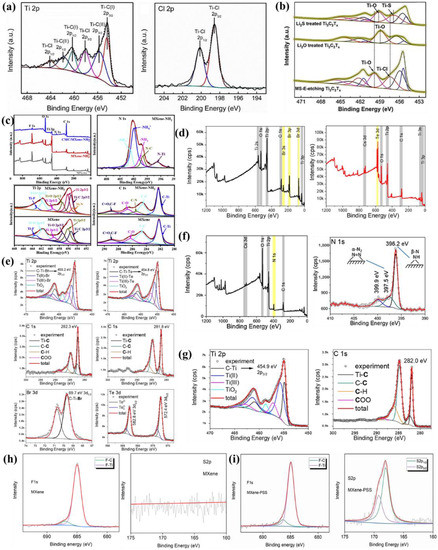
Figure 315. ( a ) XPS spectra of Ti 2p and Cl 2p of Ti 3 C 2 Cl 2 [1] [ 27 ]. ( b ) High-resolution Ti 2p spectra of -O and -S terminations Ti 3 C 2 T x powders [3][ 44 ]. ( c ) XPS spectra of MXene-NH 2 [5] [ 55 ]. ( d ) XPS spectra of Ti 3 C 2 Br 2 and Ti 3 C 2 Te MXene [ [10]29 ]. ( e ) The left is the high-resolution XPS spectrum of Ti 3 C 2 Br 2 MXene, and the right is the high-resolution XPS spectrum of Ti 3 C 2 Te MXene [10][ 29 ]. ( f ) XPS spectra of Ti 3 C 2 (NH)MXene [10][ 29 ]. ( g ) The high-resolution XPS spectrum of Ti 3 C 2 □ 2 MXene [10][ 29 ]. ( h ) XPS spectra of F 1s and S 2p of Ti3C2Tx MXene. ( i ) XPS spectra of F1s and S2p of Ti3C2Tx-PSS [11][ 60 ].

Figure 416.
(
a
) XPS spectra of F 1
s
and S 2
p
of Ti
3
C
b
) XPS spectra of F 1
s
and S 2
p
of Ti
3
C
2
T
4. It HAS TEM
TEM and spherical aberration-corrected electron microscopy can directly observe the atomic composition of MXene at the atomic scale, and the surface terminations of heavy elements can be directly observed [ [11]60 ]. With the help of sample preparation techniques such as frozen section and FBI, ultrathin samples can be obtained, and the arrangement of spatial terminations in the MXene layer can be observed. Depending on the support of testing methods such as EDX and EELS, atomic identification, valence analysis, and coordination relationship judgment can be realized at the atomic scale. In addition, the structure analysis of MXene can be realized by selecting the comparison between electron diffraction and XRD. Figure 517 a is a TEM image of Ti 3 C 2 Cl 2 MXene with organ-like morphology. Figure 517 b is a TEM image of MXene-NH 2 similar to graphene. In addition, the HRTEM image and its selected area electron diffraction pattern (inset) confirm that the crystal structure of the aminated nanosheets is the same as that of conventional MXene. Sardar et al. Modified MXene with PEG6 and observed the morphology by TEM. Figure 17 5c shows TEM images of pristine Ti 3 C 2 MXene flakes and modified Ti 3 C 2 -PEG6, respectively. Any small nanoparticles formed in the form of TiO 2 nanoparticles in the Ti 3 C 2 -PEG6 flakes were not observed. In addition, the length of Ti 3 C 2 -PEG6 flakes is in the order of microns. These results indicate that the chemical modification of the Ti 3 C 2 MXene flakes does not change the size of the MXene flakes and does not lead to any oxidation of the MXene flakes. This is an important discovery for maintaining the structural integrity of the Ti 3 C 2 MXene flakes. Yu et al. achieved surface amino functionalization of Nb 2 CT x MXene by hydrazine treatment. Figure 17 5d,e are TEM and HRTEM images of pristine P-Nb 2 CT x and T-Nb 2 CT x MXene with amino functionalization. All the Nb 2 CT x MXene exhibited a typical 2D morphology, and the size and thickness of Nb 2 CT x MXene did not change before and after treatment. HRTEM images of P-Nb 2 CT x and T-Nb 2 CT x MXene nanosheets indicate that the lattice parameters of P-Nb 2 CT x and T-Nb 2 CT x MXene nanosheets are 0.27 nm. In addition, the corresponding selected area electron diffraction (SAED) patterns of P-Nb 2 CT x and T-Nb 2 CT x MXene nanosheets are shown in the inset. This means that the P-Nb 2 CT x and T-Nb 2 CT x MXene nanosheets have hexagonal structures.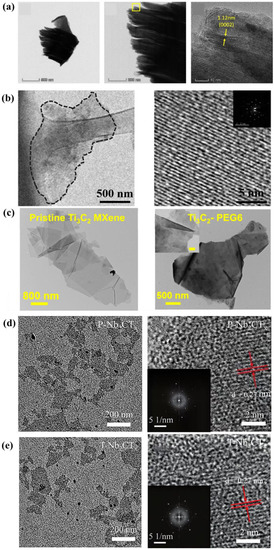
Figure 517.
TEM images of (
a
) Ti
3
C
2
Cl
b
) MXene-NH
c
) Ti
3
C
d
) P-Nb
2
CT
e
) T-Nb
2
CT
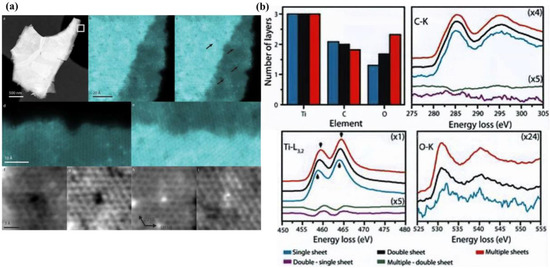
Figure 618.
(
a
) HAADF STEM images of Ti
3
C
2
T
b
) EELS averaging over Ti
3
C
2
T
5. Raman and FTIR
Raman spectroscopy is an analytical method based on the Raman scattering effect discovered by the Indian scientist C.V. Raman, which analyzes the scattering spectrum with different frequencies from the incident light to obtain information on molecular vibration and rotation, and is applied to the study of molecular structure. Raman spectrometer features: (1) No contact or damage to the sample, and the sample does not need to be prepared. (2) Rapid analysis and identification of the characteristics and structure of various materials. (3) Suitable for black water and water samples, accurate measurement in high, low temperature, and high-pressure conditions. Application directions of Raman spectroscopy: Raman spectroscopy is a molecular structure characterization technique based on the Raman effect, and its signal comes from the correlation between molecular vibration and rotation. The analysis directions of Raman spectroscopy are as follows:-
Qualitative analysis: Different substances have different characteristic spectra, so qualitative analysis can be carried out by spectra.
-
Structure analysis: The analysis of spectral bands is the basis of material structure analysis.
-
Quantitative analysis: According to the absorbance characteristics of the spectrum of substances, one can have a good ability to analyze the amount of substances.
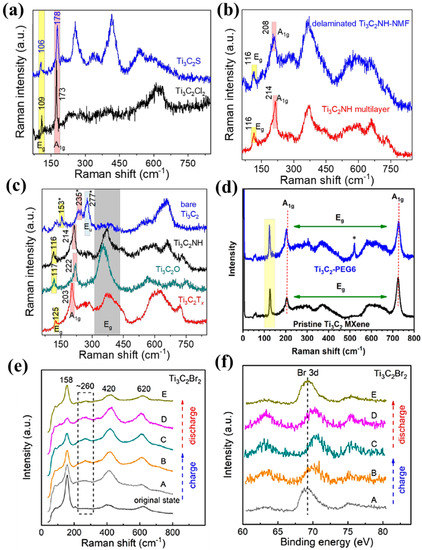
Figure 719. ( a ) Raman spectra of Ti 3 C 2 MXene at surface terminations of Cl, S [10][ 29 ]. ( b ) Ti 3 C 2 MXene at NH surface terminations [ [10]29 ]. ( c ) NH, O terminations, and naked MXene [ [10]29 ]. ( d ) Ti 3 C 2 -PEG6 sheets [14][ 38 ]. ( e ) Structure and composition change of the Ti 3 C 2 Br 2 electrode after cycling [4][ 28 ]. ( f ) For Ti 3 C 2 Br 2 , the voltage of each point is A: 0.3 V, B: 1.3 V, C: 2.2 V, D: 1.2 V, E: 0.3 V [4][ 28 ].
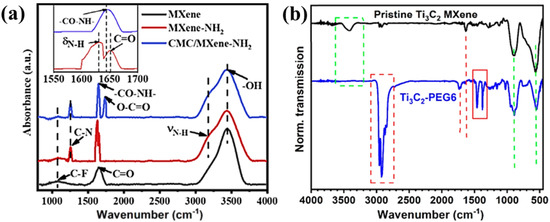
Figure 820.
(
a
) FTIR spectroscopy analysis of MXene-NH
b
) pure Ti
3
C
6. Others
Figure 921 a shows Ti 3 C 2 with Cl atoms as surface terminations. Ti 3 C 2 Cl 2 MXene shows good ordering along the basal plane, which is consistent with the strong (000l) peak in the XRD pattern. The electronic band structure and phonon spectrum calculated by DFT for a single layer of Ti 3 C 2 Cl 2 , which is essentially a metallic layer with a finite density of states at the Fermi level, are shown in Figure 921 b. The phonon spectra also show that all phonon frequencies are positive, i.e., Ti 3 C 2 Cl 2 MXene is dynamically stable [ [1]27 ].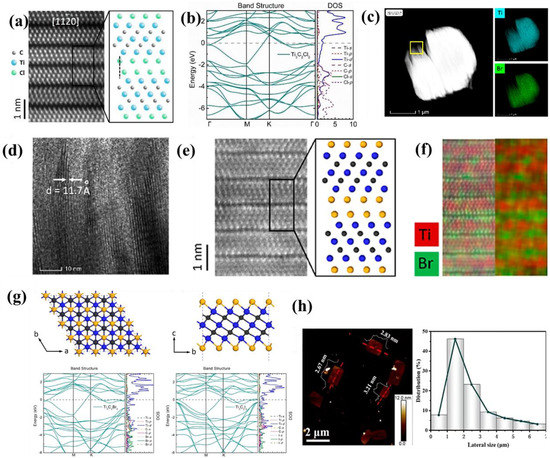
Figure 921. ( a ) The STEM/EDS of Ti 3 C 2 Cl 2 MXene [1][ 27 ]. ( b ) Electron band structure and phonon spectrum of monolayer Ti 3 C 2 Cl 2 calculated by DFT [ [1]27 ]. ( c ) The HAADF-STEM image of Ti 3 C 2 Br 2 and corresponding EDS element map [4][ 28 ]. ( d ) The HR-TEM image of Ti 3 C 2 Br 2 [4] [ 28 ]. ( e ) The STEM image of Ti 3 C 2 Br 2 [4] [ 28 ]. ( f ) EDS element diagram corresponding to Figure 21 e [ [4]28 ]. ( g ) Atomic and electronic structure of Ti 3 C 2 Br 2 , and Ti 3 C 2 I 2 [4] [ 28 ]. ( h ) AFM image and size distribution of MXene-NH 2 nanosheets [ [13]49 ].
